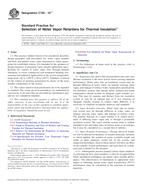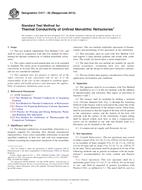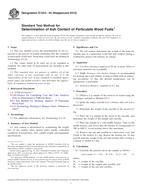1.1 This test method is applicable to preformed or field manufactured thermal insulation products, such as board stock foams, rigid fibrous and composite materials manufactured with or without protective facings. See Note 0 This test method is not applicable to high temperature, reflective or loose fill insulation.
Note 0
If the product is manufactured with a facer, test product with facer in place.
1.2 This test method involves two stages: preconditioning and environmental cycling. During the first stage, 25 mm (1 in.) thick specimens are used to separate two environments. Each of these environments has a constant but different temperature and humidity level. During the environmental cycling stage, specimens also divide two environments namely constant room temperature/humidity on one side and cycling temperature/ambient relative humidity on the other side.
1.3 This test method measures the ability of the product to maintain thermal performance and critical physical attributes after being subjected to standardized exposure conditions. A comparison is made between material properties for reference specimens stored in the laboratory for the test period and specimens subjected to the two-stage test method. To eliminate the effect of moisture from the comparison, the material properties of the latter test specimens are determined after they have been dried to constant weight. The average value determined for each of the two sets of specimens is used for comparison.
1.4 Different properties can be measured to assess the effect of environmental factors on thermal insulation. This test method requires that thermal resistance be determined based upon an average for three specimens measured after completing the test. Secondary elements of this test method include visual observations such as cracking, delamination or other surface defects, as well as the change in moisture content after each of the two stages of exposure prescribed by the test method.
1.5 Characterization of the tested material is an essential element of this test method. Material properties used for characterization will include either compressive resistance or tensile strength values. The compressive resistance or tensile strength is measured on two sets of specimens, one set conditioned as defined in and a set of reference test specimens taken from the same material batch and stored in the laboratory for the whole test period. For comparison, an average value is determined for each of the two sets of specimens.
1.6 &si-value;
This standard does not purport to address all of the safety concerns, if any, associated with its use. It is the responsibility of the user of this standard to establish appropriate safety and health practices and determine the applicability of regulatory requirements prior to use.
Product Details
- Published:
- 08/01/2007
- Number of Pages:
- 5
- File Size:
- 1 file , 97 KB
- Redline File Size:
- 2 files , 180 KB


